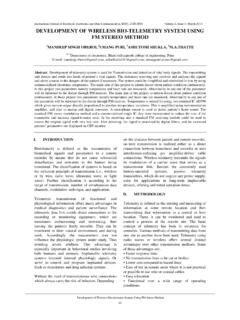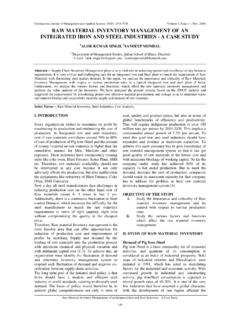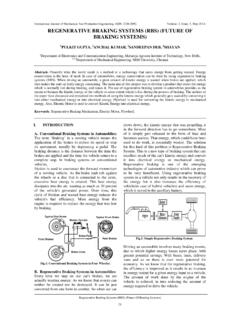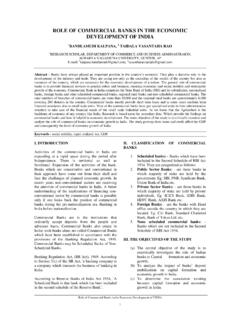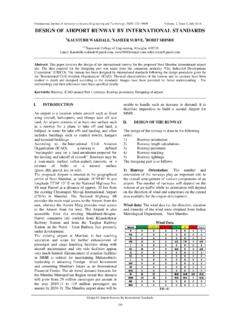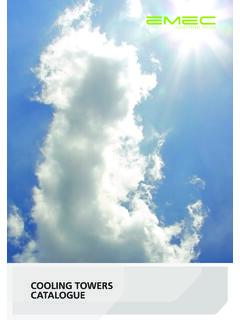Transcription of PERFORMANCE ANALYSIS OF NATURAL DRAFT WET …
1 International Journal of Mechanical And Production Engineering, ISSN: 2320-2092, Volume- 2, Issue-10, PERFORMANCE ANALYSIS of NATURAL DRAFT Wet cooling Tower at Optimized Injection Height 1 PERFORMANCE ANALYSIS OF NATURAL DRAFT WET cooling TOWER AT OPTIMIZED INJECTION HEIGHT 1 ALOK SINGH, 2 SANJAY SONI, 3R. S. RANA 1 Assistant Professor, 2 Associate Professor, 3 Mechanical Engineering Department Maulana Azad National Institute of Technology, Bhopal, ( ) E-mail: Abstract- cooling tower is an integral part of thermal power generation plant. Basically cooling tower are heat rejection devices used to transfer waste heat to the atmosphere. Investigation involves the two-dimensional computational fluid dynamics model based on actual reference conditions. Temperature and humidity inside the tower are having main influence on the PERFORMANCE of NATURAL DRAFT cooling tower. At optimum injection height tower cooling range (difference of temperature between hot water inlet and cold water outlet) is about , which sufficiently capable of increasing the effectiveness of cooling tower.
2 This leads to increase of effectiveness by , which results in improved efficiency of power plants. The resulting optimal injection height reduces the relative humidity by at the outer radius of tower. Keywords- NATURAL DRAFT wet cooling tower, CFD. I. INTRODUCTION cooling towers are main part of various industrial process as well as thermal power plants. They are often used in power generation plants to cool the condenser feed-water [1]. Here, the cooling tower uses ambient air to cool warm water coming from the condenser in a secondary cycle. There are many cooling tower designs or configurations. In dry cooling tower water is passed through finned tubes forming a heat exchanger so only sensible heat is transfered to the air. In wet cooling tower the water is sprayed directly into the air so evaporation occurs and both latent heat and sensible heat are exchanged.
3 In hybrid tower a combination of both approaches is used. cooling towers can further be categorised into forced or NATURAL DRAFT towers . Forced units tend to be relatively small structures where the air flow is driven by fans. In a NATURAL DRAFT cooling tower the air flow is generated by NATURAL convection only. The DRAFT is established by the density difference between the warm air inside the tower and the cool dense ambient air outside the tower. In a wet cooling tower, the water vapor inside the tower contributes to the buoyancy and tower DRAFT . A further classification is between counter-flow and cross -flow cooling towers . In cross -flow configuration, the air flows at some angle to water flow, where as in counter-flow the air flows in the opposite direction to water flow [1,2]. II. NATURAL DRAFT WET cooling TOWER This paper is concerned with NATURAL DRAFT wet cooling towers (NDWCT) in counter-flow configuration.
4 These structures are most commonly found in power generation plants. The main components of NATURAL DRAFT wet cooling tower are nozzle, fill, drift elimenator and water basin. The warm water is sprayed a grid of nozzle over the packing. The packing or fill is a multi-layered lattice with large specific air to water contact surface, which obstructs the free fall of water, thereby extending the heat and mass transfer time [3]. The fill breaks up water flow into droplets, increases the contact area and contact time with air, and therefore improves the heat transfer rate and efficiency of cooling tower. Figure :1 NATURAL DRAFT wet cooling tower [1] The air enters the tower horizontally through the rain zone where it initially flows in a partly counter flow and partly cross flow manner before being drawn axially into the fill and up into the tower.
5 The air leaving the fill is generally supersaturated. III. MODELING OF cooling TOWER In order to ANALYSIS the different parameter of cooling tower first the 2-D computational fluid dyamics model is develoded as actual reference condition of panipat power generation plat. The CFD code FLUNT 12 is used for modeling of tower. International Journal of Mechanical And Production Engineering, ISSN: 2320-2092, Volume- 2, Issue-10, PERFORMANCE ANALYSIS of NATURAL DRAFT Wet cooling Tower at Optimized Injection Height 2 IV. GEOMETRY Initially 2-D, CFD model of NATURAL DRAFT cooling tower is created considering important details. The structure of cooling tower model imagined in advance due to possibilities in the subsequent steps depended on the composition of different geometrical shapes. Some assumption were made to take into account the main features of real construction of cooling tower [4,7].
6 2-D symmetric model is developed; fixing the fill corresponding to real arrangement. Inlet and outlet space is created at bottom and top of the tower cooling tower shell is considered as a wall with zero thickness and its profile is formed by curve with three point including throat. Assuming symmetrical thermal and flow field in the model, only one half of the cooling tower is modeled with a symmetry boundary condition. The effect of cooling water piping is modeled by porous zone boundary condition with appropriate pressure loss coefficient in the air flow. The outlet of the peak cooler cells is created with rectangular cross -section in the model without the transition piece to circular cross -section. The fans were modeled by the fan model of FLUENT 12 at the exit planes. Reference conditions Tower height 130 m Air inlet height 10 m Fill depth 1 m Tower basin diameter 98 m Fill base diameter 95 m Tower top diameter 68 m Spray zone height 12 m Water flow rate 10,000 lit/s Water inlet temperature 311 K Ambient air temperature 299 K Ambient air humidity 55 % Ambient pressure 101 kpa After geometry, mesh is generated.
7 During mesh generation much attention is to be paid with mesh quality requirement recommendation in FLUENT 12. In order to have an appropriate resolution of the flow field inside the cooling tower the computational domain is define into a large number of finite volume cells. Different parts are meshed with different element sizing. Fill zone are fine meshed. By using mapped face meshing the model with appropriate element sizing is created. After mesh generation naming of different parts of cooling tower is done. The inner and outer surface of the wall inside the model, have identical shapes, so the mesh sizes on the two sides of the walls can be same. In order to have an appropriate resolution of the flow field in the vicinity of and inside the cooling tower, the computational domain was discretised into a large number of finite volume cells. Detail from the mesh is illustrated from bottom region of the cooling tower quadrilateral face mesh elements.
8 Figure:2 Half Meshed view of cooing tower V. BOUNDARY CONDITIONS The operating condition is, at a point 130 m upstream from the centre line of the cooling tower at ground level and acceleration due to gravity is specified as m/s2. For this approach an operating temperature of K and an operating density of kg/m were entered. At walls zero heat flux boundary condition is applied (adiabatic walls). For momentum equation no slip shear condition is prescribed and a wall roughness height is specified. In FLUENT 12 an equivalent sand grain roughness height should be used with the default roughness constant of When determining the equivalent sand-grain roughness height for the physical roughness height of different walls, recommendations in literature are applied. Velocity inlet boundary condition is used to define the inlet velocity and other properties of air.
9 Velocity magnitude of air takes normal to the boundary of inlet [10]. Turbulence is taken as intensity and length scale. Thermal condition and species in mole fraction is defined. Outlet is defined as pressure out-let of air. Other zones are also defined likewise [5,8]. VI. GOVERNING EQUATIONS The numerical model has been built within FLUENT 12. This study examines only the flow in the tower under constant wind conditions. International Journal of Mechanical And Production Engineering, ISSN: 2320-2092, Volume- 2, Issue-10, PERFORMANCE ANALYSIS of NATURAL DRAFT Wet cooling Tower at Optimized Injection Height 3 The governing equations for incompressible steady fluid flow can be written as: ( u ) = S (1) where is the air density (kg/m3), u is the fluid velocity (m/s), is the flow variable and is the diffusion coefficient for and S the source term.
10 These equations can be expanded into the individual momentum and transport equations which, together with the continuity equation give the Navier-Stokes Equations. The continuity equation for conservation of mass in Cartesian coordinates for transient flow can be given as, + .( v)=S (2) where S is the mass source term. The steady equation is obtained by simply neglecting the transient terms / t, from the left hand side. The equation for conservation of momentum can be written as, t( u )+ x u u = x + x u x + u x +S (3) where S is now a source term for momentum. The source term for buoyancy can be written as, S ( ) (4) The transport equation for a scalar can be written as: ( )+ = + (5) The cooling tower geometry and specifications are based on a NDWCT located at Panipat Power station, Panipat (Haryana).

